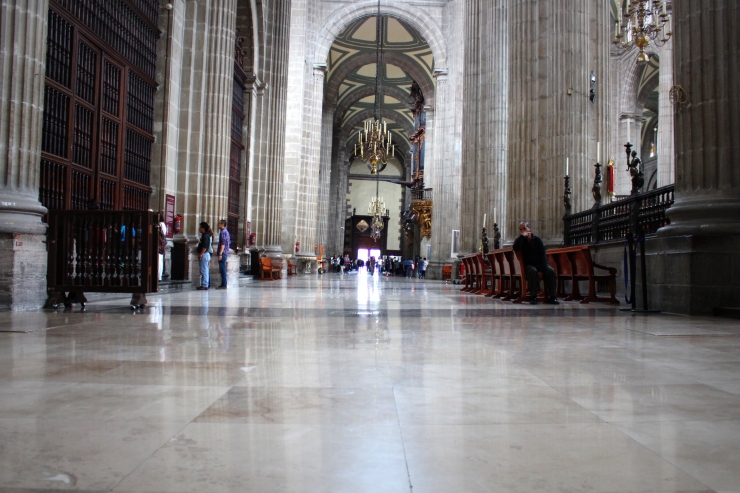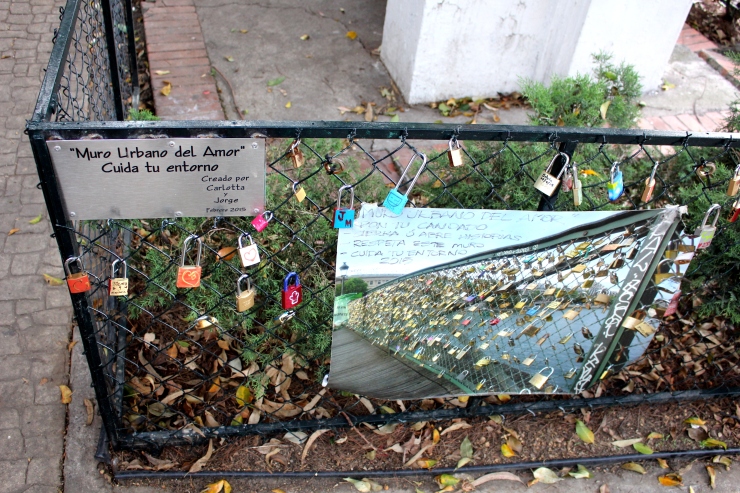Mexico City, or el DF (distrito federal) to which it is more commonly referred: both Julien and I, when thinking of how we would describe the city came up with some version of “big” and “busy”. This is not surprising; Mexico City has all sorts of records. Long-time holder of the most populated city in the world title, it is still the most populated in the western hemisphere with 21.2 million people spread across nearly 600 square miles. No doubt a daunting task for a tourist to take on a city of such magnitude, we luckily had our friend Jenny’s suggestions to help hone in on a few select sights, as well as David’s (our friend and host here in MC) lovely hand-drawn map.
 México, surnommée couramment el DF (Distrito Federal) par les locaux : Ce sont des mots comme “immense”, “bruyante” ou “animée” qui nous viennent à la bouche pour la décrire. Par très surprenant après tout ; México détient un certain nombre de records. Longtemps détentrice du status de ville la plus peuplée du monde (record tenu aujourd’hui par Tokyo), elle est aujourd’hui la ville la plus peuplée du monde occidental avec 21,2 millions d’habitants étalés sur près de 1500km². Ce n’est donc pas une tâche facile que de jouer les touristes sur ce terrain de jeu. Heureusement nous avons pu nous appuyer sur de précieuses suggestions de notre amie Jenny ainsi qu’une magnifique carte synthétique de México dessinée à la main par notre hôte David.
México, surnommée couramment el DF (Distrito Federal) par les locaux : Ce sont des mots comme “immense”, “bruyante” ou “animée” qui nous viennent à la bouche pour la décrire. Par très surprenant après tout ; México détient un certain nombre de records. Longtemps détentrice du status de ville la plus peuplée du monde (record tenu aujourd’hui par Tokyo), elle est aujourd’hui la ville la plus peuplée du monde occidental avec 21,2 millions d’habitants étalés sur près de 1500km². Ce n’est donc pas une tâche facile que de jouer les touristes sur ce terrain de jeu. Heureusement nous avons pu nous appuyer sur de précieuses suggestions de notre amie Jenny ainsi qu’une magnifique carte synthétique de México dessinée à la main par notre hôte David.
 As you can clearly see, the city is divided east from west by a major avenue, Avenida de los Insurgentes. Generally speaking, the points of interest for tourists are located to the west of the avenida, the historic center and a neighborhood called La Roma being the exceptions. Day one, we toured about the historic center by foot, navigating tourist hotspots and figuring out public transport. There are many public systems in place to get around el DF: busses, metros, metrobusses, trams, bikes…where we don’t go by foot, we have learned to take the metro and metrobusses (5 and 6 pesos/trip respectively, about $.40). Both are appreciable for their efficiency, simplicity, and low-cost.
As you can clearly see, the city is divided east from west by a major avenue, Avenida de los Insurgentes. Generally speaking, the points of interest for tourists are located to the west of the avenida, the historic center and a neighborhood called La Roma being the exceptions. Day one, we toured about the historic center by foot, navigating tourist hotspots and figuring out public transport. There are many public systems in place to get around el DF: busses, metros, metrobusses, trams, bikes…where we don’t go by foot, we have learned to take the metro and metrobusses (5 and 6 pesos/trip respectively, about $.40). Both are appreciable for their efficiency, simplicity, and low-cost.
Our first stop was the Zócalo, Mexico City’s main plaza. On one side is the cathedral, two other sides government buildings, and the last is filled with shops and restaurants. The view of the cathedral clearly shows how the city sinks in some places. Originally a small island in the middle of a lake, Mexico City is actually built upon said lake, and it shows. Buildings all across the city are dancing in an unorganized manner, constructions new and old tilting left or right.
Here are some photos from our first day in el DF.
Comme vous pouvez le voir clairement, la ville est divisée en deux par l’axe nord-sud que constitue l’Avenida de los Insurgentes. De manière générale, les points d’intérêt touristiques se trouvent dans la moitié à l’ouest de cette avenue, à l’exception du centre historique et du quartier appelé La Roma. Pour notre premier jour nous avons choisi d’harpenter le Centro Historico à pied, d’aller voir les monuments incontournables et de nous familiariser avec les moyens de transport qu’offre la ville. Pour se déplacer il n’y a que l’embarras du choix : bus, métro, métrobus, tram, vélos… quand les pieds nous lâchent nous prenons le métro ou le métrobus (5 ou 6 pesos par trajet soit environ 0,35€). Les deux sont très appréciables car efficaces (on peut se rendre partout), simples et pas chers (on cherche à tenir notre budget dès le départ).
Notre premier arrêt était le Zócalo, la place principale de México. Sur l’un des côtés se dresse la cathédrale, sur deux autres se trouvent les bâtiments gouvernementaux, et le dernier côté est tout simplement gorgé de boutiques et restaurants. La cathédrale montre clairement que la ville s’enfonce par endroits. A l’origine México a été fondée sur une petite île au milieu d’un lac et la Ciuidad de Mexico s’est ensuite construite sur le lac, ce qui se voit aujourd’hui. Partout dans la ville les bâtiments, qu’ils soient anciens ou nouveaux, penchent aléatoirement à gauche ou à droite.
Voici quelques photos de notre premier jour ici à el DF.
 Tilted floors, or are they leaning columns?
Tilted floors, or are they leaning columns?
 The busy pedestrian street, Calle de la Moneda / La Calle Moneda, rue piétonne tranquille
The busy pedestrian street, Calle de la Moneda / La Calle Moneda, rue piétonne tranquille
 Julien recovering from his first very spicy sauce /// Ils rigolent pas avec les sauces épicées ici.
Julien recovering from his first very spicy sauce /// Ils rigolent pas avec les sauces épicées ici.
 Khaki-uniformed music-box street-performer
Khaki-uniformed music-box street-performer
 Note the chandelier with the energy efficient light bulb hanging off the bottom – Iglesia de San Francisco /// Notez l’ampoule à économie d’énergie équipant le chandelier.
Note the chandelier with the energy efficient light bulb hanging off the bottom – Iglesia de San Francisco /// Notez l’ampoule à économie d’énergie équipant le chandelier.
 Julien and I were interviewed by some university students who had an assignment to talk to anglophones so the students would feel more at ease speaking English. There weren’t a lot of follow-up questions to the answers we gave, but the students were very pleasant.
Julien and I were interviewed by some university students who had an assignment to talk to anglophones so the students would feel more at ease speaking English. There weren’t a lot of follow-up questions to the answers we gave, but the students were very pleasant.
 Temporary exhibit in the Palacio de Iturbide
Temporary exhibit in the Palacio de Iturbide
 Protest approaching the Plaza de La República
Protest approaching the Plaza de La República
 Mini-fence to feed the love-locks epidemic – La Condesa
Mini-fence to feed the love-locks epidemic – La Condesa
 Walking around the beautiful La Condesa, the neighborhood we’re calling home this week (more on this soon), jet-lag hitting our eyeballs /// Balade dans le très sympathique quartier de la Condesa
Walking around the beautiful La Condesa, the neighborhood we’re calling home this week (more on this soon), jet-lag hitting our eyeballs /// Balade dans le très sympathique quartier de la Condesa
 Rooftop terrace drinks in the Historic Center to wrap up our first day in Mexico City – Azul Histórico
Rooftop terrace drinks in the Historic Center to wrap up our first day in Mexico City – Azul Histórico
 To the left, our gracious host, David. We met David when he was studying at Science Po in Paris in 2011 and thanks to the powers of facebook we’ve maintained contact, and luckily so! His apartment is located in the hip Condesa neighborhood and has made for a perfect welcome to the Americas. David’s ever-enthusiastic suggestions of places to see and insight on Mexican history and politics has been indispensable in making us feel at ease at the start of our adventure.
To the left, our gracious host, David. We met David when he was studying at Science Po in Paris in 2011 and thanks to the powers of facebook we’ve maintained contact, and luckily so! His apartment is located in the hip Condesa neighborhood and has made for a perfect welcome to the Americas. David’s ever-enthusiastic suggestions of places to see and insight on Mexican history and politics has been indispensable in making us feel at ease at the start of our adventure.
A gauche, David, notre ami qui nous héberge dans le quartier de la Condesa. Nous l’avons rencontré en 2011 quand il a étudié à Science Po à Paris. C’est une très belle opportunité de pouvoir débuter notre voyage avec un pied-à-terre de ce genre. David nous a donné de précieux conseils pour visiter la ville et sa vision personnelle de l’histoire et de la politique locale.









My beautiful children,
Love all the pictures… some of them made me laugh such as Julien’s recovery from spicy food and the one he seems to be hiding from the camera… the busy street… busy with people….
Why were there so many policemen on the street?
Enjoy the rest of your stay in el DF!!
LikeLike
There were protests kind of linked with the midterms they had over the weekend. The specific protest we photographed was of the teachers demanding better working conditions and remembering the 43 students that disappeared earlier this year.
LikeLike
Ah… yes I had heard of those students that disappeared and possibly are dead… Way too sad…. As the parents still await their return… it is getting harder and harder to find them…
The picture I thought was Julien… now with my glasses I see that it isn’t him.
Dad and I are enjoying you r writing…. you have a way with words… (There is a program on the radio with that title… A Way With Words on Sunday morning) Keep us informed and we will be happy!!
LikeLike
“La cathédrale montre clairement que la ville s’enfonce par endroits. A l’origine México a été fondée sur une petite île au milieu d’un lac et la Ciuidad de Mexico s’est ensuite construite sur le lac, ce qui se voit aujourd’hui. Partout dans la ville les bâtiments, qu’ils soient anciens ou nouveaux, penchent aléatoirement à gauche ou à droite.”
Meuh oui, bien sûr !!! C’est juste une excuse pour les photos qui ne seraient pas prises droites, ça !!! ^_^
Merci pour ces magnifiques vues !! Quel orgue ! Tout donne envie…
LikeLiked by 1 person
Magnifiques photos ! Cela nous fait penser un peu aux églises d’Espagne, notamment la cathédrale de Séville. Quant à la rue tranquille, elle nous rappelle celle de Bordeaux (une vraie marée humaine).
Bisous à tous les 2.
LikeLike
Effectivement il y a l’influence espagnole qui se voit dans les monuments.
J’ai un avantage dans les marées humaines mexicaines, j’ai une tête de plus que tout le monde 🙂
LikeLike